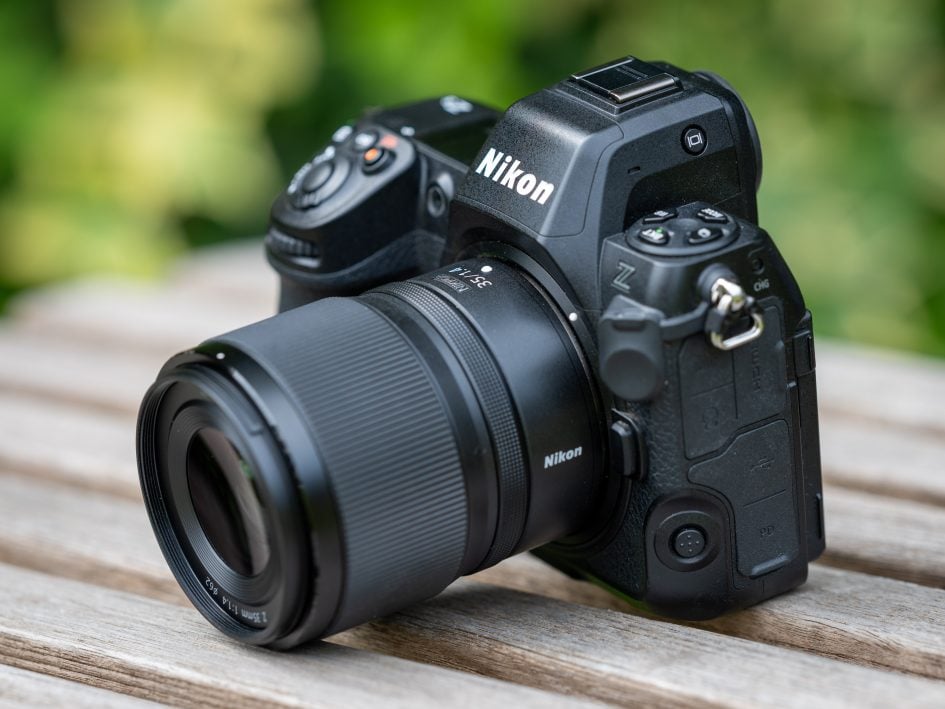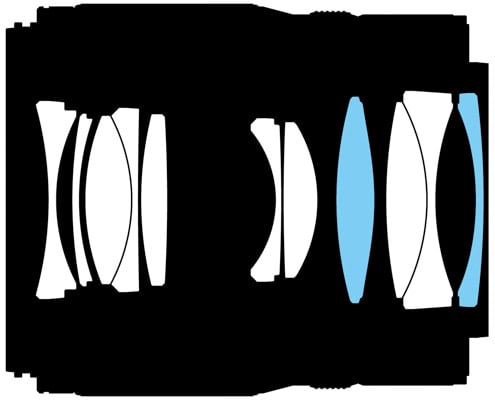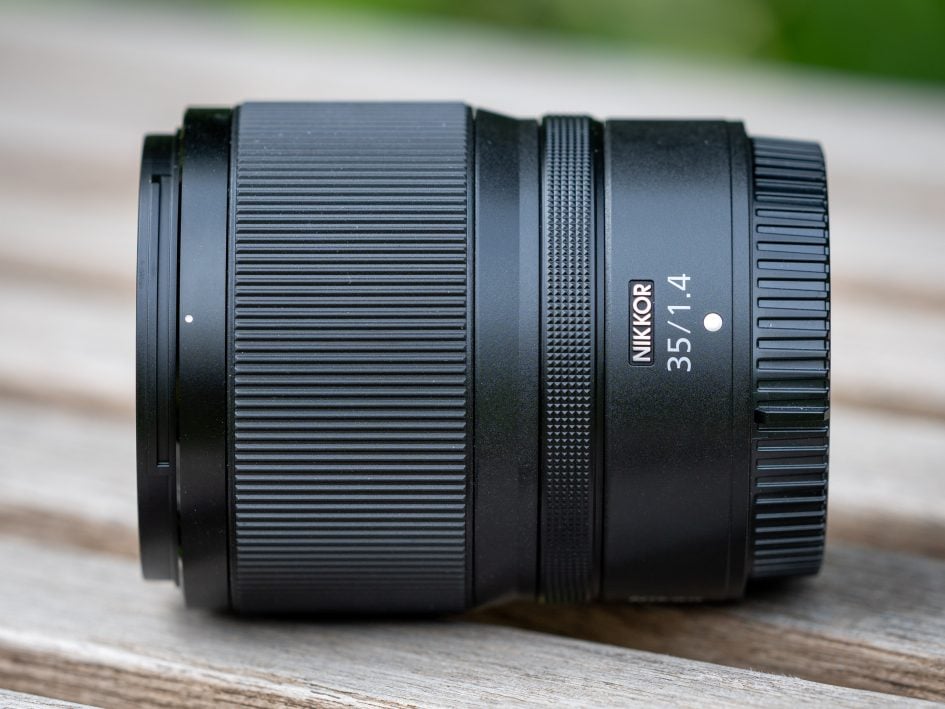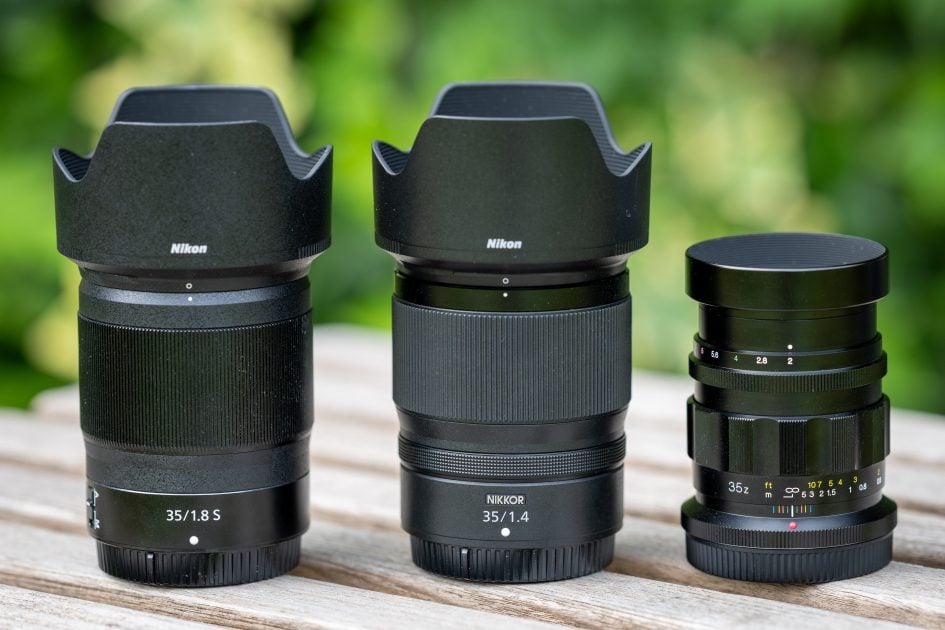Nikon Z 35mm f1.4 review
-
-
Written by Thomas
Intro
The Z 35mm f1.4 is not the lens everyone was expecting: Nikon’s last lens roadmap from October 2023 showed an S-line 35mm lens expected to be large, heavy, expensive, and f1.2 as it was placed alongside their other f1.2 prime lenses. Now Nikon brings us their first f1.4 lens for Z-mount which only weighs a bit over 400g, is relatively compact, and at 729 EUR / 597 USD / 649 GBP very affordable. And in a welcome deviation from their f1.8 line of prime lenses Nikon also added a separate control-ring to the focus ring. The Z 35mm f1.4 is corrected for full-frame sensors and is made in China.
Facts and features
Let’s compare Nikon’s Z 35mm f1.4 to their Z 35mm f1.8 S (for more details on that lens see my Nikon Z 35mm f1.8 S review). As usual I’ve rated the features with a [+] (or [++]), when it’s better than average or even state of the art, a [0] if it’s standard or just average, and [-] if there’s a disadvantage.
Size (diameter x length): 75 x 87mm (3.0 x 3.5in.), the lens hood adds 48mm (89mm diameter). The Z 35mm f1.8 S is 73 x 86mm + 48mm lens hood. Both lens hoods have the same geometry and can be used interchangeably but have different part numbers. [+]
Weight: 415g (14.7 oz.) plus 30g for the plastic lens hood. The Z 35mm f1.8 S is 364g + 30g lens hood. [+]
Optics: 11 elements in 9 groups including 2 aspherical elements which is similar to the Z 35mm f1.8 S. [+]
Minimum object distance is 0.28m (0.92ft.) which results in a very short working distance of 18cm. The Z 35mm f1.4 has a maximum magnification of 1:5.1 which is not much. A magnification of 1:10 is achieved at 0.44m object distance. The Z 35mm f1.8 S achieves a maximum magnification of 1:4.8 with manual focus. [0]
Image stabilization: Both lenses have no optical stabilization (VR). But Nikon’s full-frame Z bodies provide built-in sensor-shift stabilization over 5 axis – plus an optional electronic stabilization in video mode. [0]
Filter-thread: Both lenses use 62mm filters. [+]
Autofocus: Both lenses offer autofocus with built-in focus drive. Manual-focus override is by simply turning the dedicated focus ring. The focus ring has the usual variable gearing which allows for very precise manual focus when turned slowly. You can reverse the focus ring direction and switch to linear response with different settings for focus throw in camera. [+]
Aperture ring: The Z 35mm f1.4 has a slim multi-function control ring which can be assigned to operate the aperture (which is the default), exposure compensation, or ISO sensitivity – or simply switched off. It is located behind the focus ring. On the Z 35mm f1.8 S the focus ring can be configured to act as multi-function ring – but then you lose the manual focus override functionality. [+]
Lens profile: All Z-Nikkors come with a lens profile which can be controlled from the camera. Vignette control offers the usual options of High, Normal, Low and Off. Diffraction compensation can be activated or deactivated. Auto distortion control is always On and cannot be deactivated. [+]
Both lenses cover full frame/FX or smaller sensors. [+]
Price: 729 EUR (incl. 19% VAT) / 597 USD / 649 GBP. The Nikon Z 35mm f1.8 S currently sells for 759 EUR / 697 USD / 649 GBP. The manual focus Voigtländer 35mm f2 APO-Lanthar which I’ll use for comparing optical performance costs 1099 EUR / 749 USD / 849 GBP. [+]
The Z 35mm f1.4 comes without a pouch but the lens hood is included and reversible for transport. [0]
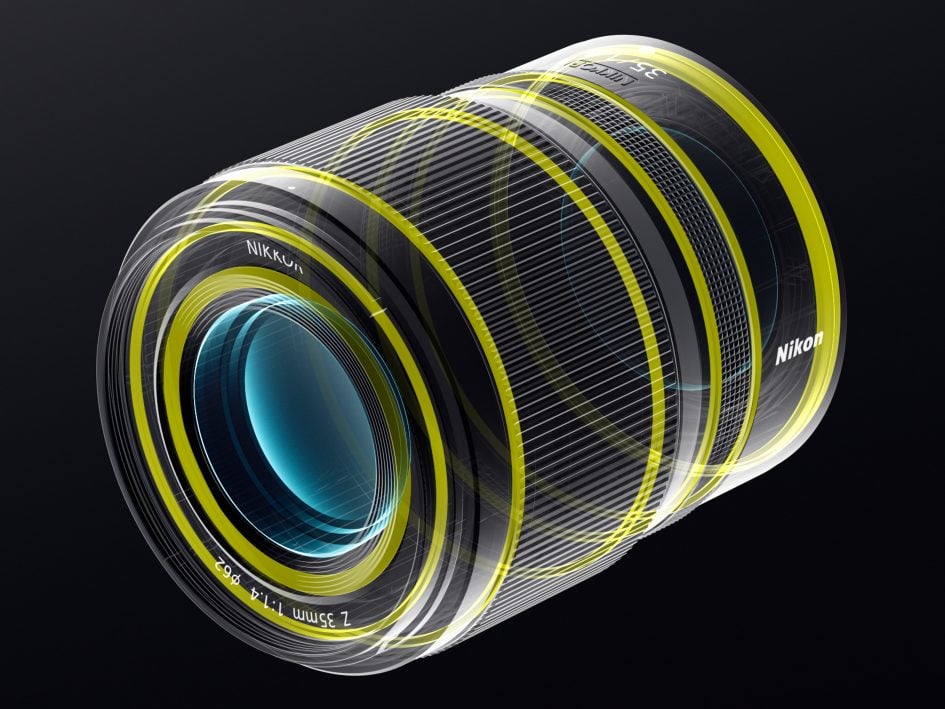
Sealing: yes. Both lenses have a rubber grommet at the lens-mount plus further special weather-sealing throughout the construction. [+]
At a score of 0[-]/3[0]/10[+] the Nikon Z 35mm f1.4 turns out to be well featured: The lens is pretty compact and lightweight, it has a large f1.4 focal ratio but is still less expensive than the Z 35mm f1.8 S. Plus it has a multifunction ring in addition to the focus ring which makes handling of different functions much more comfortable than on the one-ringed Z 35mm f1.8 S.
If the new lens can also score with decent optical performance and a softer Bokeh the Z 35mm f1.4 should be a very interesting alternative to the Z 35mm f1.8 S.
Three 35mm lenses with Z-mount
Above: Nikon Z 35mm f1.8 S, Nikon Z 35mm f1.4, Voigtländer 35mm f2 APO-Lanthar
Focus
Focus accuracy and repeatability is critical to consistently produce sharp shots. Repeatability (the accuracy of focus on the same subject after repeated focus-acquisition) of the Nikon Z 35mm f1.4 is good (measured 96.0% in Reikan FoCal with max defocus) with no outlier over a series of 40 shots on the well-lit and contrasty focus test target. But there is quite some focus variation whether the lens focuses from a closer distance or from infinity: coming from infinity netted the better results. On a Nikon Z8 the lens focuses in 0.60 sec from infinity to 0.44m (1:10 magnification) which is quite a bit slower than the Z 35mm f1.8 S at 0.37 sec. Hunting wasn’t an issue.
The focus ring is 33mm wide, has a rubberized surface, and moves smoothly. The control ring is 8mm wide with a textured surface.
AF-operation of the lens emits a faint hum in photo-mode or if you record video with the built-in microphone.
As you pull focus, you’ll notice a bit of focus breathing: the image became 2.6% less magnified when I adjusted focus from infinity to 0.44m. This is pretty unobtrusive when shooting videos although a bit stronger than on the Z 35mm f1.8 S (0.7% reduction).
Image stabilization
To test the effectiveness of the image stabilization with the Nikon Z 35mm f1.4 on a Nikon Z8 camera body, I did a series of 140 test-shots hand-held with shutter speeds from 1/40 of a second down to 0.8 sec. I used the shots at 1/40 sec with VR=off as reference of how good my handholding was at the time of the test and Reikan FoCal did the chore of evaluating the sharpness of all shots.
Here’s the results: With VR=on the stabilization from the camera produced no outliers in the 40 shots from 1/40 down to 1/10 sec (2 stops) with (average) sharpness clearly better than at 1/40 sec with VR=off. At 1/5 sec (3 stops) there were 5 less than optimal results in 20 shots. At 0.4 sec (4 stops) results became clearly worse than at 1/40 sec with VR=off. I’d rate that a stabilization effect from the camera of 3 stops. Which is less than I expected but still allows you to confidently shoot the lens at 1/10 sec with excellent results.
Next check out my quality results!
Check prices on the Nikkor Z 35mm f1.4 at B&H, Adorama, WEX UK or Calumet.de. Alternatively get yourself a copy of my In Camera book, an official Cameralabs T-shirt or mug, or treat me to a coffee! Thanks!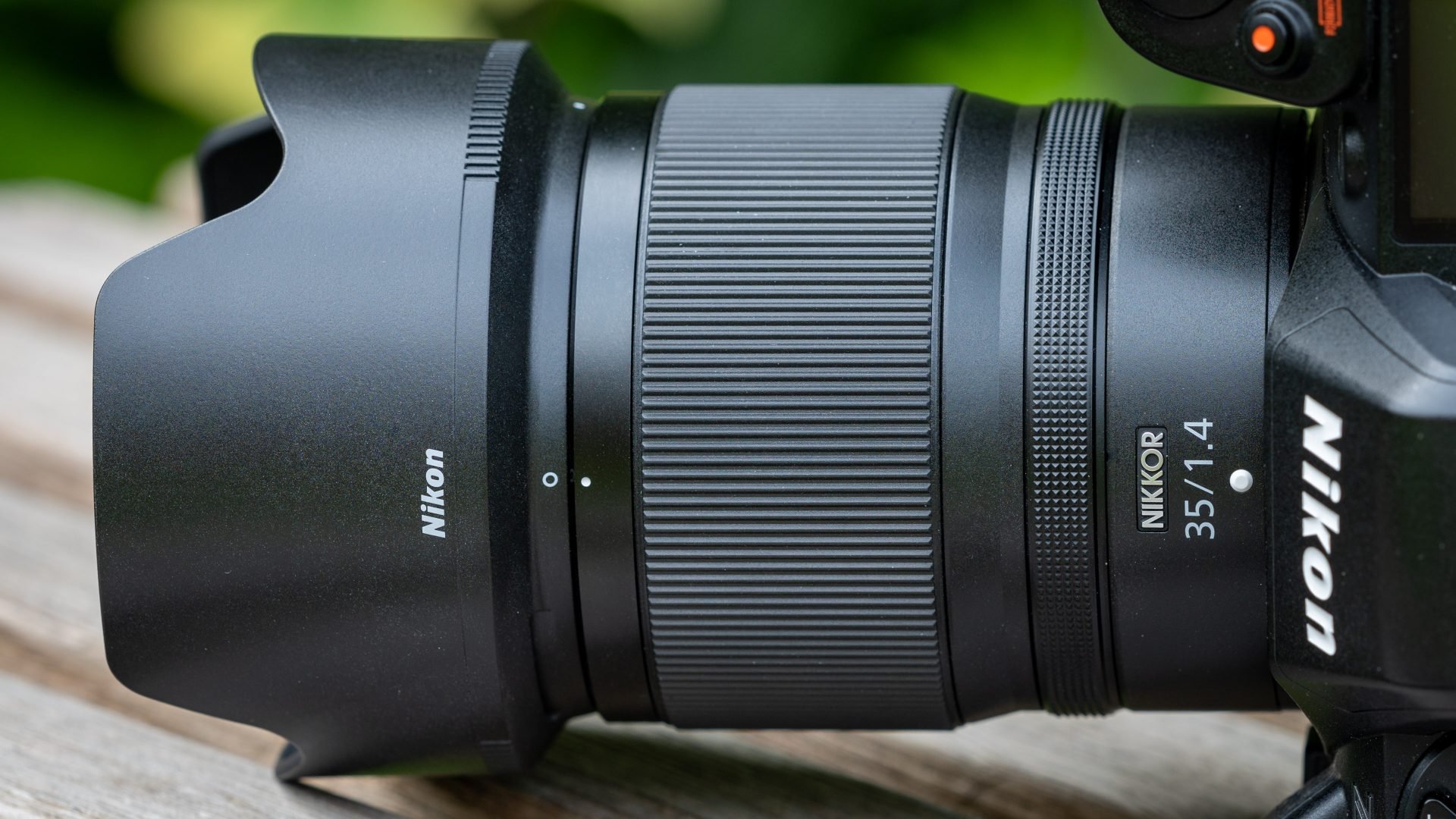
 Nikon’s Z 35mm f1.4 is an interesting entry into a third line of Z-mount prime Nikkors: much smaller and lighter (physically and price-wise) than an f1.2 version would be it offers a 2/3 stop better light gathering power, better Bokeh, plus a separate focus and control ring over the Z 35mm f1.8 S at a lower price. And the Z 35mm f1.4 shows good resolution across the full frame at longer distances. But: Contrast and color aberrations are not well controlled, close-up performance is weak, there's heavy vignetting, and the lens shows strong field-curvature at closer distances. If you value the benefits of the large f1.4 aperture and can live with these deficiencies I can still recommend the Z 35mm f1.4 based on its good price-performance ratio.
Nikon’s Z 35mm f1.4 is an interesting entry into a third line of Z-mount prime Nikkors: much smaller and lighter (physically and price-wise) than an f1.2 version would be it offers a 2/3 stop better light gathering power, better Bokeh, plus a separate focus and control ring over the Z 35mm f1.8 S at a lower price. And the Z 35mm f1.4 shows good resolution across the full frame at longer distances. But: Contrast and color aberrations are not well controlled, close-up performance is weak, there's heavy vignetting, and the lens shows strong field-curvature at closer distances. If you value the benefits of the large f1.4 aperture and can live with these deficiencies I can still recommend the Z 35mm f1.4 based on its good price-performance ratio.